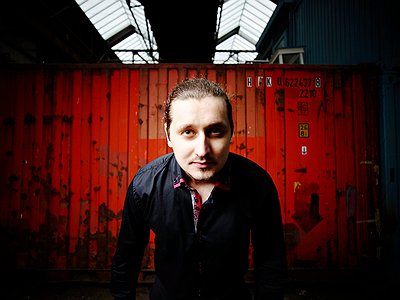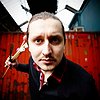Part 1
Name: Konstantyn Napolov
Nationality: Ukrainian
Occupation: Percussionist
Current Release: The Collectors on TRPTK
Recommendation: Igor Stravinsky "Le Sacre du Printemps (The Rite of Spring)"/ Arvo Pärt's "My Heart's in the Highlands"/ Glenn Gould’s recordings of works by J.S. Bach.
Website/Contact: Find out more about Konstantyn at his website www.k-napolov.com
When did you start writing/producing music - and what or who were your early passions and influences? What is it about music and/or sound that drew you to it?
I was first properly introduced to music when I started music lessons at the age of 6. I began learning the guitar, saxophone and the drums, but I didn’t have the right kind of passion for it when I was that age – I was more interested in other activities and games such as hide and seek. My parents, in particular my father, both did their best to encourage me and nurture my talents, and I’m enormously grateful to them for it.
I developed an interest in percussion aged 9 or 10. I won a few regional junior competitions and started to play in a local big band. Music became a central part of my life when I was accepted into the Piotr Stolarsky School. That was a really big honour and a huge responsibility.
I didn’t have a huge passion for classical music at that age; I was taught it at school but it didn’t interest me that much. At home, my father listened to the powerful voices of Robert Plant and Roger Waters, and the technical brilliance of Brian May, Carlos Santana, Jimi Hendrix and many others. I think this is what eventually drew me in and, slowly but surely, formed my passion.
For most artists, originality is first preceded by a phase of learning and, often, emulating others. How would you describe your own development as an artist and the transition towards your own voice? What is the relationship between copying, learning and your own creativity?
It is always important to discover your own meanings and build interpretations, but I think these have to be based on knowledge. To find your “own voice” as an artist is especially important if your work is going to be heard, or even ‘assessed’ by the wider public. Your concept has to be clear in your mind, then rehearsed until it is perfect with no room for error.
For over 6 years, I was busy doing professional competitions, auditions, and other international events, being judged by top professionals from all over the world. Most of those competitions I won because of my experience and years of hard practising, followed by lots of international masterclasses. I believe that losing can also be a learning opportunity, if you ask questions and understand why.
From these experiences, I gained a sense of what was considered acceptable and what was not, and in between those boundaries I tried to create my “own voice”.
In competitions and auditions the result is completely dependent on the opinions of jury members, so you have to stay within certain parameters. Performing on stage in a concert, however, is quite different. It is down to you to sell your interpretation to the audience without such restrictions.
At the moment, I’m busy with my project, The Dutch Golden Collection, where I’m expanding the percussion repertoire by commissioning new works. This is a completely different style of working again – you are creating something brand new, so your “own voice” is the most important. You are sharing ideas with the composer and writing your own story, therefore it’s even more important that the piece is rich in your own style.
What were your main compositional- and production-challenges in the beginning and how have they changed over time?
Honestly, there aren’t any huge challenges that spring to mind. Of course, there are always challenging techniques, choosing the right material and instruments, difficult passages in a piece, memorizing a complex text, networking, sponsoring, and so on. For me though, this is just part of the joy of the job as an artist. The profession is based on constant learning and perfecting our skills and ourselves.
What was your first studio like? How and for what reasons has your set-up evolved over the years and what are currently some of the most important pieces of gear for you?
As a percussionist, there are always difficulties with practice studios and performance spaces because no two set-ups are ever the same. This was especially apparent during my Master’s degree. It doesn’t matter how many instruments or how much equipment the conservatory has: when you’re preparing for important competitions or auditions you will need to put together your own set-up in different rooms. This can consist of at least two or three set-ups, with thirty or more instruments in total. On top of this, those rooms and some of the instruments from your set-up will be taken and used by twenty or more other students a few times per day. Although it all depends on communication and your relationships with peers, it’s not always possible to practice in the same room every time. So, I had to ask one of my teachers, who supported me, if I could practice for a few months in his studio and use his equipment. I’m still grateful to him.
The other important part is your instruments. Percussion instruments are infamously expensive - I have chosen the path of competing both to raise my profile and to be able to afford the best professional instruments.
How do you make use of technology? In terms of the feedback mechanism between technology and creativity, what do humans excel at, what do machines excel at?
I love the sound of acoustic percussion but I do quite often perform pieces using playback and interactive electronics. It is quite exciting and feels a bit like playing a duet with a robot.
At this point in time, machines and robots are still not able to feel emotions or identify senses in the way that humans can. This also applies to the best humanoid robot so far – Sophia. Whilst they are programmed to learn via machine learning, they still can’t benefit in the same way from experiencing artistic challenges. We, as humans, can find answers to our problems where we don’t expect them, as well as achieving self-improvement. I feel it is important to remember that art mainly consists of feelings and emotions.
Production tools, from instruments to complex software environments, contribute to the compositional process. How does this manifest itself in your work? Can you describe the co-authorship between yourself and your tools?
I can’t speak for composers because at this point in my career I am not one. Although I have made a few relatively large arrangements of classical works for percussion, it still involves completely different processes, but I can consider this question as a performer.
As a percussionist, I think my range of tools is quite wide – definitely one of the widest ranges in comparison to other instrumentalists, due to the sheer number of instruments that come under the umbrella term of ‘percussion’. And, of course, one of the most important elements of practicing and creation is making sure you have the best professional instruments and mallets. The “co-authorship” between you as a musician or artist and your instruments or tools can reach even higher levels of cooperation if you clearly understand and take time to discover all the possible ranges and capabilities of your instruments. Even then, you can discover something new and surprising from them!
Collaborations can take on many forms. What role do they play in your approach and what are your preferred ways of engaging with other creatives through, for example, file sharing, jamming or just talking about ideas?
I don’t like to separate different kinds of art. For me, dance involves the same emotional spectrum as painting, just from a different perspective. Sometimes we can even hear the painting and we can definitely hear dance. It can be quite interesting to use senses other than the usual ones for different kinds of art.
I love collaborating with other artists because we can both learn so much from it and perfect our own skills. I’ve been working with contemporary ballet company and Eurythmy for more than 5 years, and it is fascinating to learn to feel the music from perspectives other than as a performer or as a listener. The same applies to the film industry or other visual arts – one piece of music can be interpreted completely differently depending on the video or picture played along with it. Collaborations with live painters have also brought me plenty of new ideas and inspirations.
Could you take us through a day in your life, from a possible morning routine through to your work? Do you have a fixed schedule? How do music and other aspects of your life feed back into each other - do you separate them or instead try to make them blend seamlessly?
I consider myself as a really happy and lucky person, because at this stage of my life I’m completely occupied by passion for my profession, and I can make a living from it without having to be involved in any other kind of work. I think clear priorities and following main goals is the key.
I have two types of daily life plans: tightly scheduled and not scheduled at all. When I’m working to a tightly scheduled plan, it’s normally during really busy periods with lots of concerts, presentations, interviews and other events, including day-to-day responsibilities and concentration. During this time, I work all day, leaving seven to eight hours for sleep.
I wake up at 7:00/7:30 and, with a cup of coffee on the windowsill, start working on emails and admin work straight away. Three or four times per week I’ll go to the gym and then straight to the studio. I have to be there before 10:00am to be able to start practicing. Practicing for me not only involves physically playing the instruments, but also reading music, analysing it, listening to it.
Three days a week I teach, starting from 16:30. On the days I am free from teaching, I sometimes have scheduled meetings with programmers, colleagues, management, journalists, and more. If not, then I’ll continue practicing.
Concerts usually start at 19:00 or 20:00. These days are my favourites. I have to be at the concert hall four to five hours before the performance to be able to set-up, rest and sound check.
Doing nothing for at least 2-3 hours per day is also part of the job. It is especially effective in the evening before sleep.
I am based in The Hague, The Netherlands and most of my frequent destinations can be easily reached by bike. For example, it takes around 10 minutes on a bike from my home to my studio, and the same applies to the gym or central meeting places. Even if I need to travel to another city, it only takes around an hour to get there.






